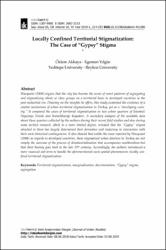| dc.contributor.author | Akkaya, Özlem | |
| dc.contributor.author | Yılgür, Egemen | |
| dc.date.accessioned | 2021-03-11T20:13:22Z | |
| dc.date.available | 2021-03-11T20:13:22Z | |
| dc.date.issued | 2019 | |
| dc.identifier.issn | 1307-9905 | |
| dc.identifier.issn | 2602-2133 | |
| dc.identifier.uri | https://doi.org/10.31198/idealkent.431380 | |
| dc.identifier.uri | https://app.trdizin.gov.tr/makale/TXprd09EUTRPQT09 | |
| dc.identifier.uri | https://hdl.handle.net/20.500.12879/29 | |
| dc.description.abstract | Wacquant (2008) argues that the city has become the scene of novel patterns of segregating and stigmatizing ethnic or class groups on a territorial basis in developed countries in the post-industrial era. Drawing on the insights he offers, this study examined the existence of a similar mechanism of urban territorial stigmatization in Turkey, yet as a “developing country.” It compared the cases of territorial stigmatization in two urban quarters of İstanbul: Nişantaşı Teneke and Rumelikavağı Kayadere. A secondary analysis of the available data about these quarters collected by the authors during their recent field studies and also during some archive research, albeit to a more limited degree, revealed that the “Gypsy” stigma attached to them has largely determined their formation and trajectory in interaction with their socio-historical contingencies. It also showed that unlike the cases reported by Wacquant (2008) as regards to developed countries, these stigmatized urban districts in Turkey are not simply the outcome of the process of deindustrialization that accompanies neoliberalism but that their history goes back to the late 19th century. Accordingly, the authors introduced a more nuanced sub-term to handle the aforementioned socio-spatial phenomenon: locally confined territorial stigmatization. | en_US |
| dc.description.abstract | Wacquant’a göre (2008) post-endüstriyel dönemde gelişmiş ülkelerin kentlerinde, etnik ya da sınıfsal grupların mekânsal temelde ayrıştırılmaları ve damgalanmalarının yeni örüntüleri ortaya çıkmıştır. Onun öngörülerinden hareketle, bu çalışmada bu kez “gelişmekte olan bir ülke” olarak Türkiye’de kentsel mekânsal damgalama olgusu ile benzerlik gösteren bir mekanizmanın varlığı inceleme konusu yapılmıştır. Çalışma kapsamında İstanbul’un iki mahallesindeki mekânsal damgalama örnekleri karşılaştırılmıştır: Nişantaşı Teneke ve Rumelikavağı Kayadere. Yazarların yakın dönemlerde gerçekleştirdikleri saha çalışmalarında ve daha kısıtlı bir düzeyde olsa da bazı arşiv araştırmalarında mahalleler hakkında topladıkları verilerin ikincil analizi, bu mahallelerin “Çingenelik”le damgalanmasının, oluşumlarını ve yörüngelerini sosyo-tarihsel olumsallıklarıyla etkileşim içinde büyük ölçüde belirlemiş olduğunu açığa çıkarmıştır. Aynı zamanda çalışmada ortaya konulan bulgular, Wacquant’ın (2008) ele aldığı gelişmiş ülkelerdeki örneklerden farklı olarak, Türkiye’deki bu damgalanmış kentsel yerleşim alanlarının basitçe neoliberalizme eşlik eden sanayisizleşme sürecinin bir sonucu olarak ortaya çıkmadıklarını ve bu mahallelerin tarihinin geç 19. yüzyıla uzandığını göstermiştir. Sonuç olarak yazarlar, söz konusu sosyo-mekânsal fenomenin ele alınabileceği daha nüanslı bir alt-terim önermişlerdir: yerel düzeyle sınırlı mekânsal damgalama. | en_US |
| dc.language.iso | eng | en_US |
| dc.rights | info:eu-repo/semantics/openAccess | en_US |
| dc.subject | [Anahtar Kelime Yok] | en_US |
| dc.title | Locally Confined Territorial Stigmatization: The Case of “Gypsy” Stigma | en_US |
| dc.title.alternative | Yerel Düzeyle Sınırlı Mekânsal Damgalama: “Çingene” Damgası Örneği | en_US |
| dc.type | article | en_US |
| dc.contributor.department | Beykoz Üniversitesi Sivil Havacılık Yüksekokulu | en_US |
| dc.contributor.institutionauthor | Yılgür, Egemen | |
| dc.identifier.volume | 10 | en_US |
| dc.identifier.issue | 26 | en_US |
| dc.identifier.startpage | 214 | en_US |
| dc.identifier.endpage | 253 | en_US |
| dc.relation.journal | İdealkent | en_US |
| dc.relation.publicationcategory | Makale - Ulusal Hakemli Dergi - Kurum Öğretim Elemanı | en_US |


















